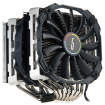Hi guys I'm looking for suggestions for an awesome QUIET (has to be quiet) air cooler that will fit my ASUS Maximum Forumla vii z97 board. It needs to cool an overclocked 5ghz 4970K with good temps. I also have corsair platinum ram and their profiles are quite high. The case is a Phanteks P400S Mid tower.
If this cooler had white leds that would be even better!
What can you guys suggest please? Every AIO cooler I've had sounds like a leaf blower, even on the quite modes.
Best regards.
If this cooler had white leds that would be even better!
What can you guys suggest please? Every AIO cooler I've had sounds like a leaf blower, even on the quite modes.
Best regards.






 Sound can be directional, but fans radiate sound in all directions .. so do rustling leaves and quiet bedrooms. My point was most of the time the ambient noise level arround us is 20-30db.
Sound can be directional, but fans radiate sound in all directions .. so do rustling leaves and quiet bedrooms. My point was most of the time the ambient noise level arround us is 20-30db.